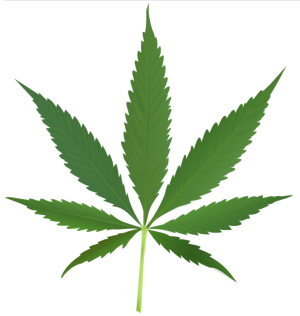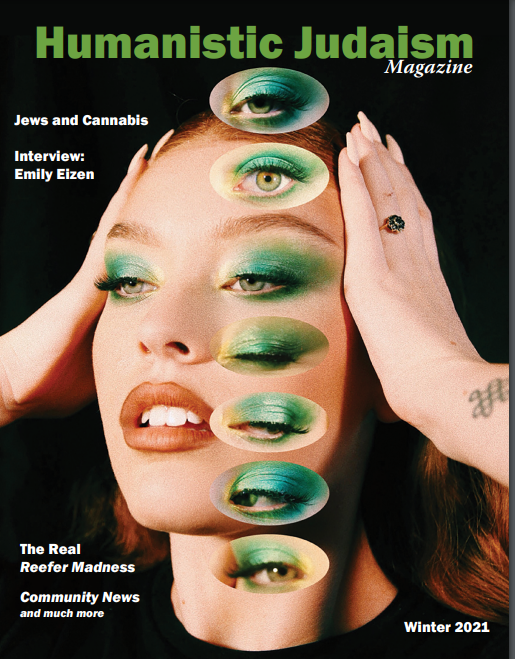by James M. Braum
This article was first published in the Winter 2021 issue of Humanistic Judaism magazine.
The relationship between cannabis and Judaism is very old, older than most of our cherished cultural practices, so it seems appropriate to look at this history and bring it into our ongoing Jewish conversation, particularly as it relates to the experience of Jewish Humanists.
Cannabis and the Ancient Israelites
It is believed that the ancestors of the ancient Israelites first encountered cannabis as it was being dispersed (alongside grapes and horses) throughout the region by the Assyrians, from the plant’s origins in Central Asia. Like many of their neighbors in the region, they used the plant for its fiber and as medicine.1
Until recently, scholars debated whether cannabis was used in religious settings in ancient Israel, with most of the debate centering on whether Kaneh Bosum, one of the original prescribed ingredients of the Jerusalem Temple’s incense formula, was in fact cannabis. A recent discovery at Tel Arad 2 may have answered this question. Remnants of burnt cannabis resin were found on the incense altars of a Judean satellite worship shrine from circa 760–715 BCE.
This discovery gives new possible layers of meaning to the biblical narrative, such as when God allegedly punished Judean King Uzziah 3 for taking it upon himself to burn incense, rather than waiting for a priest to do the task. While the traditional interpretation of the text centers on Uzziah’s pridefulness in usurping a traditional task assigned to the Levitical priesthood, could it be possible that instead, Uzziah was condemned for getting into the priestly stash?
Cannabis in Rabbinic Judaism
The destruction of the Second Temple might have ended the use of cannabis in the temple rituals but it did not end the use of Jewish cannabis use, with the Talmud discussing cannabis as a mundane part of Jewish life.4 Cannabis was also used medically, including by Maimonides who prescribed cannabis oil to treat ear and respiratory infections.5
The use of cannabis as a recreational intoxicant was favorably mentioned by Rabbi ben Solomon ibn Abi Zimra, Chief Rabbi of Cairo for much of the 1500s CE, who has been quoted as saying “the leaves of cannabis bring simcha.” Finally, as the use of hashish spread from the Middle East to North Africa,6 Jews (in partnership with Berbers) were actively involved in the hashish trade and consumed it themselves.7
Evolving Understandings of the Use of Cannabis in Modern Judaism
During the modern era,8 Jewish practices began to focus less on local custom (minhag) and more on denominational/movement affiliation as well as individual conscience and preference. These trends which would shape the relationship of Jews and cannabis.
By the late 1800s, many Americans made use of cannabis as medicine, most often as liquid extracts. Starting in the early 1900s, smoking cannabis became popular, first among poor immigrant communities in the US American Southwest. Predictably, racism and classism led to cannabis prohibition in the United States and many other countries in the 1930s. This ended most medical use of cannabis, while it forced recreational use underground, where its use continued to spread.
By the 1950s, the prohibitions against cannabis made it a marker of outsider culture, so it should not
surprise us that more and more Jews, who felt like outsiders, embraced cannabis. One example was Lenny Bruce, whose standup routines often talked about both Jewish culture and cannabis in the same shows. In his 1965 autobiography, How to Talk Dirty and Influence People, Bruce wrote, “Marijuana will be legal someday, because there are so many law students that smoke pot, who will someday become Senators and they will legalize it to protect themselves… And yet at this very moment there are American citizens in jail for smoking flowers.” Bruce was not alone, as there were other prominent Jews becoming well known for their love of cannabis, most notably Mezz Mezzrow,9 Bob Dylan,10 and Allen Ginsburg.11
By the 1970s the growing popularity of cannabis among Jewish people even sparked one of President Richard Nixon’s most notorious anti-Semitic rants caught on the White House tapes:
“There’s a funny thing, every one of the bastards who is out there to legalize marijuana is Jewish. What
the Christ is the matter with the Jews, Bob? What is the matter with them? I suppose because most of
them are psychiatrists, (unintelligible) . . . so many of the psychiatrists are Jewish.” 12
In the 1960s and onward, some Jews began to return to the use of cannabis as a component of their spiritual practice. Many of these practitioners emerged in new Jewish movements that sought to reclaim long-abandoned Jewish cultural practices, often through the plethora of lay-led chavurot.
One of the most legendary of these experimenters was Rabbi Zalman SchachterShalomi (aka “Reb Zalman”), best known today as the co-founder of the Jewish Renewal movement. Earlier in his life he was ridiculed for suggesting that it would be preferable to replace the four cups of Passover wine with four puffs of marijuana,13 but he and others continued to speak about the role of cannabis and other psychedelic drugs as tools for spirituality. While these rebels were largely scorned by many of the Jewish institutions of their day, their efforts served to open the doors for further conversation.
Today’s Jewish Cannabis Conversation
Today, with rapidly changing cultural norms and laws, it is time to engage in not only conversation about cannabis, but conversation that is informed by our history. I suggest that this conversation might best be approached by considering cannabis’s four primary contemporary uses: (1) industrial hemp, (2) medical use, (3) recreational use, and (4) spiritual use. The first two categories are widely (but not universally14) accepted by most Jewish movements, with the second two categories being more controversial.
The debate over recreational cannabis use is largely fought between those who see it as no different than other socially accepted recreational intoxicants and appropriate when used in moderation 15 and those who oppose recreational use because of perceived potential dangers.16
Also controversial is the fourth category, spiritual use. Today, many find thoughtful consumption to be a helpful adjunct to Jewish meditation and mindfulness practice, given the plant’s ability to transform mundane experiences into the realm of holiness, much as the recitation of a blessing might transform a simple meal into a different experience. Moreover, many also note that consumption can lead to a deepened sense of connection to all of nature and humanity itself, and a loss of the sense of “otherness” that traditional religion places between us all.
While there is no replacement for first-hand experience, one of the best accounts of the spiritual experience of cannabis is found in the writings of Jewish astronomer Carl Sagan,17 who wrote at age 35 of his experiences with cannabis in sparking creativity, increasing sensual pleasure, and of developing a different perspective on life and the universe. We will close with some of Sagan’s words:
I do not consider myself a religious person in the usual sense, but there is a religious aspect to some highs. The heightened sensitivity in all areas gives me a feeling of communion with my surroundings, both animate and inanimate…. Cannabis brings us an awareness that we spend a lifetime being trained to overlook and forget and put out of our minds. A sense of what the world is really like can be maddening; cannabis has brought me some feelings for what it is like to be crazy, and how we use that word ‘crazy’ to avoid thinking about things that are too painful for us. In the Soviet Union political dissidents are routinely placed in insane asylums. The same kind of thing, a little more subtle perhaps, occurs here: ‘did you hear what Lenny Bruce said yesterday? He must be crazy.’ When high on cannabis I discovered that there’s somebody inside in those people we call mad.
- Barney Warf, “High Points: A Historical Geography of Cannabis” Geographical
Review (Oct. 2014), also see Clarke, Robert C. and Mark D. Merlin Cannabis Evolution and Ethnobatany (Los Angeles, University of California Press, 2013), 442–448, 674. - “1st High: Ancient Israelites at Biblical Shrine Used Cannabis to Spark ‘Ecstasy’” The Times of Israel (May 4, 2020) https://www.timesofisrael.com/1st-highancient-israelites-at-biblical-shrine-used-cannabis-to-spark-ecstasy/.
- Uzziah is believed to have reigned from cir. 780–740 BCE, which overlaps with the time when the Tel Arad shrine was in use. The story of Uzziah is told in 2 Chronicles 26, https://www.sefaria.org/II_Chronicles.26?lang=bi.
- The breadth of the references to cannabis in the Talmud (and other Jewish writings) can found on Sefaria.org, also see Shulchan Arukh Orach Chayim, Siman 264, https://www.sefaria.org/Shulchan_Arukh%2C_Orach_Chayim.264.1?lang=bi.
- Susie Davidson “A Rabbi (Who’s a Doctor) Discovers Marijuana in the Bible,” Jewish Journal ( 2019), https://jewishjournal.org/2019/10/10/a-rabbi-whos-adoctor-discovers-marijuana-in-the-bible/.
- Hashish is a concentrated form of cannabis.
- Ziv Genesove, “In Moroccan Cannabis Fields, Illumination of Jewish Role in Country’s Hash Trade.” The Times of Israel, (2019), https://www.timesofisrael.com/in-moroccan-cannabis-fields-illumination-of-jewish-role-in-countryshash-trade/.
- I’m using the term “modern” to refer to the era from the 1800s onward, a time in which distinct Jewish denominations/movements sprung up in the context of pluralistic societies such as the USA and Napoleonic France.
- Mezz Mezzrow was not only a jazz musician, but also one of the most famous cannabis dealers of his time, selling to many of the jazz greats including Louis Armstrong. See https://en.wikipedia.org/wiki/Mezz_Mezzrow, also see “Louis Armstrong’s Weed Dealer Transformed Jazz,” Great Moments in Weed History Podcast, (2019), https://www.stitcher.com/show/great-moments-inweed-history-w-abdullah-and-bean/episode/louis-armstrongs-weed-dealertransformed-jazz-64811655.
- Bob Dylan famously introduced the Beatles to cannabis. Barry Stringfellow, “Physician Explores the Physical and Metaphysical Benefits of Cannabis,” MV Times (2017), https://www.mvtimes.com/2017/09/06/physician-explores-physicalmetaphysical-benefits-cannabis/.
- Martin Torgoff, “Allen Ginsberg: Marijuana Legalization Pioneer” FreedomLeaf.com (Feb. 23, 2017), https://www.freedomleaf.com/allen-ginsberg-grasshistory/.
- President Richard Nixon speaking to White House Chief of Staff H.R. (Bob) Haldeman in May 26, 1971, starting at the 4:21 mark on White House Tapes, Conversation #505–004, https://www.nixonlibrary.gov/white-house-tapes/505/conversation-505-004.
- Sara Davidson, “Remembering Rabbi Zalman Schacther Shalomi,” Tablet (2014), https://www.tabletmag.com/sections/news/articles/rememberingrabbi-zalman-schachter-shalomi also see Yaakov Ariel. “Hasidism in the Age of Aquarius: The House of Love and Prayer in San Francisco, 1967–1977.” Religion and American Culture: A Journal of Interpretation, (vol. 13, no. 2, 2003), pp. 139–165, http://www.jstor.org/stable/10.1525/rac.2003.13.2.139.
- One example is “Is Smoking Marijuana Against Halacha,” Vertical View Blog (2016), https://verticalviewblog.wordpress.com/2016/01/27/is-smokingmarijuana-against-halacha/.
- Judaism, while recognizing the dangers of substance abuse, has rarely embraced a prohibitionist approach to substances.
- Rabbi Moshe Feinstein’s 1973 ruling prohibiting cannabis use is frequently cited by opponents of Jewish cannabis use. See Igros Moshe, Yoreh De-ah 3:35 as quoted by Philmus Aaron “Kosher Cannabis: Judaism and Marijuana,” Sefaria.org, https://www.sefaria.org/sheets/12977.35?lang=bi&with=all&lang2=en.
- Nick Wing, “Carl Sagan, Marijuana advocate, explains what it’s like to be high while Carl Sagan” Huffington Post (May 31, 2013) available at: https://www.huffpost.com/entry/carl-sagan-marijuana_n_3367112. Carl Sagan’s original “Mr. X” essay, http://marijuana-uses.com/mr-x/.




rent a car doha qatar